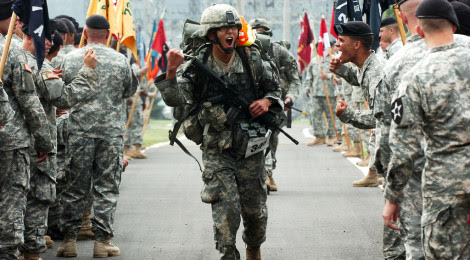
THE U.S.-SOUTH KOREAN COMBINED INFANTRY DIVISION SHOWS THE ALLIANCE IS CLOSER THAN EVER
June 11, 2015 · in Commentary
The 2nd U.S. Infantry Division recently held a ceremony to activate the first-ever combined division of U.S. and South Korean (ROK) forces. Rather than being a regression away from the transfer of wartime operational control (OPCON) of ROK forces — which would have separated the alliance command structure — this is a statement of profound operational trust that builds on a long history of combined operations between the various military organizations of these two allies. At a time when the United States faces fiscal pressures at home and China seeks to create fissures in the regional order, the U.S.-ROK alliance is moving closer together.
The current combined division concept, initiated during the tenure of Lt. Gen. Edward Cardon when he was the 2nd Infantry Division Commander, was nurtured by Maj. Gen. Thomas Vandal, and is now being implemented by Maj. Gen. Theodore Martin. It marks a fundamental continuity with, not devolution from, alliance history. During the Korean War, Gen. Paik Sun Yip’s 1st Infantry Division was assigned to the U.S. I Corps. At that time, the Korean Augmentee to the U.S. Army program (KATUSA) and the Korean Service Corps (KSC) were both established, and continue to this day. Even today, the ROK/U.S. Combined Forces Command (CFC) is arguably the most integrated combined staff in the world, including ROK and U.S. general officers who alternate between primary and deputy positions not only among the command and staff, but also in corresponding appointments down to the lowest action officer levels. Even Japan has expressed interest in establishing a combined command with the United States modeled on the ROK/U.S. CFC.
There have been many other operational examples of ROK and U.S. forces organized in a combined manner. The III U.S. Corps and XVIII Airborne Corps have occasionally been under the operational control of the Third ROK Army (TROKA) and First ROK Army (FROKA) in support of operational plans. There are also combined ROK/U.S. military service branch components, ranging from the Combined Forces Air Component Command (CFACC) to the Combined Unconventional Warfare Task Force (CUWTF). Suffice it to say that a combined division will not be difficult to make work — the concept nests within a rich tradition of ROK/U.S. alliance cooperation.
In addition to the numerous command examples above, ROK and U.S. units have routinely trained together in the decades since the Korean War; a history I’m a proud to be a part of. I recall 2nd Infantry Division units participating annually in what were then called the “Blue Dragon” river crossing exercises with ROK Marines at Kimpo. Like many others, I took part in battalion and brigade unit evaluation exercises, as well as the Super Bowl of military preparation — the exercise formerly known as Team Spirit, and today’s Foal Eagle and Key Resolve exercises. As a young 2nd Infantry Division company commander in the 1980s, I had a ROK counterpart in the 1st ROK Infantry Division. We planned and executed our own combined live-fire exercises, integrating his tank company with our infantry, TOW missile, scout and 4.2-inch mortar platoons. Combined operations aren’t just a top-down organizational chart drill; in my experience they’re a bottom-up phenomenon as well. All this training did more than just deter North Korea from invading; it gave rise to globally capable ROK combat forces, which fought with distinction in Vietnam and now operate in support of UN peacekeeping operations and other conflicts, including those in Afghanistan and Iraq.
The combined division concept recognizes the nature of the threat and the environment in Korea. The combined division will be able to focus on one of the most important missions, on the peninsula during conflict or instability: locating and securing North Korea’s weapons of mass destruction. A combined organization is well suited to this task because it harmonizes the unique capabilities, expertise, and strengths of each nation’s soldiers and their training and equipment. In addition, as U.S. forces move to a rotational force posture it will ensure more rapid integration of U.S. forces and enhance overall readiness of the division to accomplish its many missions.
(Continued at the link below)

No comments:
Post a Comment